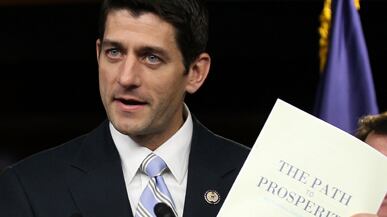On Monday afternoon, Rep. Paul Ryan, the wonky congressman from Wisconsin, gave a speech to the Economic Club of Chicago extolling the virtues of something he likes to call the Path to Prosperity. If you’ve been paying any attention at all to the deficit debates currently consuming Washington, you’ll recognize the Path to Prosperity, which passed the House in April with 235 Republican votes and will soon come up for a vote in the Senate, as the closest thing the Republican Party has to an official long-term budget plan—which makes Ryan the closest thing the Republican Party has to an official fiscal spokesman. In Chicago, Ryan played the part to the hilt. He promoted his proposal as the only “responsible,” “credible” way to reverse the “unsustainable trajectory of government spending [that] is accelerating the nation toward a ruinous debt crisis.” He warned against the Democratic alternative: “a class of governing elites picking winners and losers, and determining our destinies for us.” And he swore that all he really wants to do is “repair our safety-net programs so that they are there for those who need them most.”
Ryan’s rhetoric has its appeal. But nonpartisan analyses of the Path to Prosperity by the Congressional Budget Office and other outlets tell a very different story. If you claim, as the congressman does, to shrink deficits by $4.4 trillion over the next 10 years while reducing the government's revenue stream (a.k.a. lowering taxes) by an additional $2.9 trillion, you have to cut somewhere—and Ryan chooses to cut Medicare, Medicaid, and most of the rest of the federal budget. That’s just how his plan works (a fact that even Newt Gingrich has acknowledged). So as Capitol Hill prepares for another round of battles, and as Ryan himself begins to mull a Senate run, The Daily Beast took a closer look at something that Beltway insiders tend to ignore: the real consequences that these “ bold,” “ serious” cuts would have for real people in the real world—namely, in Ryan's own congressional district, which covers the southeastern corner of Wisconsin. The results are a stark reminder of why more politicians don’t propose such sweeping cuts, even in this dire fiscal climate: to do so is to flirt with political suicide.
Consider Medicare. If implemented, the Ryan budget would transform the program from a guaranteed, government-administered benefit into a system of subsidies that senior citizens could use to buy private insurance. It would also raise the eligibility age from 65 to 67. These changes would save the government hundreds of billions of dollars over time, according to the nonpartisan CBO, and represent a long-delayed attempt to grapple with the program’s inevitable instability. But instead of growing at the same rate as health-care costs, like current Medicare benefits, Ryan's subsidies would grow at a rate indexed to inflation, which is much, much slower. As a result, the Path to Prosperity would eventually force the 90,776 Medicare recipients currently living in Wisconsin's First Congressional District, or a full 13.5 percent of Ryan's constituents, to shell out a lot more for insurance, or to accept less bang for their buck. The federal government’s budget problem, in other words, would become a family budget problem.
The Path to Prosperity would eventually force the 90,776 Medicare recipients currently living in Wisconsin's First Congressional District, or a full 13.5 percent of Ryan's constituents, to shell out a lot more for insurance, or to accept less bang for their buck.

Esther Osmond is a good example. Current estimates show that by 2030, Osmond, an 86-year-old resident of Ryan’s hometown of Janesville, would be paying about 25 percent of her premiums and out-of-pocket costs. Under Ryan’s plan, however, her share of those costs is projected (again, by the CBO) to soar to 68 percent. At that point, Wisconsin seniors like Osmond would have a choice: either buy a Medicare-caliber private plan, which the CBO estimates would cost more than double the projected price of old-fashioned Medicare, or cut back on how comprehensive their insurance is. Reached by phone, Osmond didn’t need to hear the details of Ryan’s proposal before delivering her verdict. She knew them already. “I think it’s crazy!” she shouted. “And that’s about all I think!” Then she hung up.
Medicaid is a similar story. The Path to Prosperity would convert all federal Medicaid payments into block grants designed to give individual states more flexibility in designing their programs. But like the Medicare subsidies, Ryan’s Medicaid grants would grow at a slower rate than health-care costs. The result, according to the nonpartisan Kaiser Family Foundation, is that by 2021, Washington would be sending Wisconsin 42 percent less Medicaid money than projected under current law ($4.9 billion versus $8.5 billion); the CBO, meanwhile, estimates that Medicaid cuts would reach 49 percent by 2030, on average.
In Ryan’s district, this would amount to an estimated annual cut of $360 million—which, in turn, would affect not only the 101,500 poor, disabled, and elderly area residents who currently rely on Medicaid for coverage, but many of his other constituents as well. Faced with such a massive shortfall, the Wisconsin Department of Health Services would have to restrict services, limit enrollment, and lower payments to health-care providers—or fill the new funding gap by raising taxes and slashing other state programs. (Kaiser estimates that between 513,000 and 786,000 Wisconsinites would fall off the Medicaid rolls by 2021; proportionally, about 60,000 to 93,000 WI-1 residents would be among them.) Fewer poor people would be admitted to the more than 140 nursing homes and hospitals in Ryan’s district, which would struggle to stay afloat, and some medical professionals might lose their jobs, harming local economies. “States like Wisconsin would be forced to make some very hard decisions,” says Robin Rudowitz, Kaiser’s principal Medicaid policy analyst.
But while Ryan’s health-care changes would be drastic, the most surprising part of his plan is how much it would cut federal funding for all programs other than Medicare, Medicaid, and Social Security. Today, nonentitlement spending totals 12 percent of GDP; under the Ryan proposal, it would fall to a puny 3.5 percent by 2050, according to the CBO. Incidentally, that's exactly how much the U.S. tends to spend on defense, which Ryan doesn't cut. Last month, the “socially liberal, fiscally conservative” Center for Budget and Policy Priorities did the math and arrived at the only logical conclusion: that “most of the rest of the federal government outside of health care, Social Security, and defense would [eventually] cease to exist” if the Path to Prosperity were to become law.
The impact on Ryan’s district would be impossible to ignore. According to our analysis, which applies projections by the Center for American Progress, a progressive think tank, to current Census Bureau data, nondefense, nonentitlement investment in WI-1 would decline precipitously at first, then disappear altogether. District-wide federal spending on bridges and roads would drop by more than 37 percent, or $4.5 million, by 2021; at the same time, federal support for R&D would fall by roughly $600,000—a 28 percent reduction. The biggest short-term cuts, however, would hit WI-1's public-school system, which would watch its federal funding plummet 53 percent over the next eight years, from $72 million to $34 million.
Federal education money is usually allocated to areas with elevated poverty levels, so Ryan’s reductions would hurt his district’s largest cities (like Racine) the most. But smaller towns wouldn't be spared. If federal funding for Burlington’s 3,500-student school system were to fall from its current level ($1.52 million) to the 2021 level estimated under Ryan’s plan ($712,655), the district would be forced to raid its regular budget to prevent devastating cuts to special education, reading assistance, staff development, and subsidized lunch programs—a shuffle that might then force administrators to "reduce staff, expand class sizes, and eliminate clubs, activities, and arts and music classes," says superintendent David Moyer. Contemplating the changes, Moyer sounds distraught. "I know we're facing a fiscal crunch, and I'm not trying to put my head in the sand," he says. "But we wouldn’t be able to recapture this money locally. It would really compromise what we do." And the situation would only get worse. By 2050, there would be no money—zero—in Ryan’s budget for education, research, infrastructure, or anything else. Just health care, Social Security, and defense.
To be fair, Ryan’s constituents would get something in return for all these cuts: lower taxes. Or at least 6,770 of them would. That’s our rough estimate of the number of federal tax filers in Ryan’s district who earn more than $200,000 a year. By making the Bush tax cuts permanent and cutting the top individual tax rate from 35 percent to 25 percent—instead of restoring Clinton-era rates for the richest Americans, as President Obama has proposed to do—Ryan would reward constituents who rake in between $200,000 and $500,000 with an average tax cut ( compared with Obama’s plan) of $7,261, according to the nonpartisan Tax Policy Center (which analyzed a prototype of Ryan’s budget). That number would leap to $70,049 for the $500,000-to-$1 million crowd, and $650,981 for millionaires. To be fair, Ryan says he would like to close tax “loopholes and deductions,” which disproportionately benefit the wealthy, but his plan doesn’t specify how—so right now it’s impossible to estimate the effects. As for the other 99 percent of Ryan’s constituents, the Tax Policy Center currently predicts that their taxes would go up, with hikes ranging from $545 (for the $30,000-to-$40,000 bracket) to $1,906 (for the $100,000-to-$200,000 bracket).
As dystopian as it sounds, our analysis isn’t meant to suggest that Paul Ryan is a bad person who wants to hurt his constituents. In fact, there’s no reason to believe he is anything but what he says he is: a “lifelong conservative” determined to (a) cut taxes for individuals making more than $200,000 a year and (b) eliminate our country’s troubling $14.3 trillion debt without touching Social Security or defense. His plan to privatize Medicare, decentralize (and shrink) Medicaid, eliminate all nonentitlement, nondefense federal spending, and lower taxes for rich people is a reasonable attempt to balance the budget while staying within those philosophical parameters. The proposal is, in fact, a perfect example of what The New Republic’s Jonathan Chait has described as “conservative economic reasoning [as] a kind of backward reasoning”: it “begins with the conclusion”—that the federal government impinges on freedom and economic growth—“and marches back through the premises.”
But given the real problems that the Path to Prosperity would create for real people, including hundreds of thousands of Ryan’s own constituents, it’s important to ask whether staying within his parameters is really the wisest way to deal with the debt—especially when he’s relying on growth forecasts (2.8 percent unemployment; $150 billion a year in new economic activity; tax revenues that rise with tax cuts) that mainstream economists consider completely unrealistic. There is no shortage of other options, and many are just as “bold” and “serious” as Ryan’s. Cut defense spending. Close specific loopholes. End some (or all) of the Bush tax cuts. Raise the Social Security income ceiling. And, most important, rein in the soaring cost of health care, which is by far the largest long-term driver of America’s debt dilemma. Ryan places too much emphasis on ideology, and too little emphasis on the welfare of his constituents, to consider a single one of them. The people of Janesville had better hope that the rest of Washington is more open-minded.
With Ian Yarett
Andrew Romano is a senior writer for Newsweek. He reports on politics, culture, and food for the print and Web editions of the magazine and appears frequently on CNN and MSNBC. His 2008 campaign blog, Stumper, won MINOnline's Best Consumer Blog award and was cited as one of the cycle's best news blogs by both Editor & Publisher and the Deadline Club of New York. Follow Andrew on Twitter.






